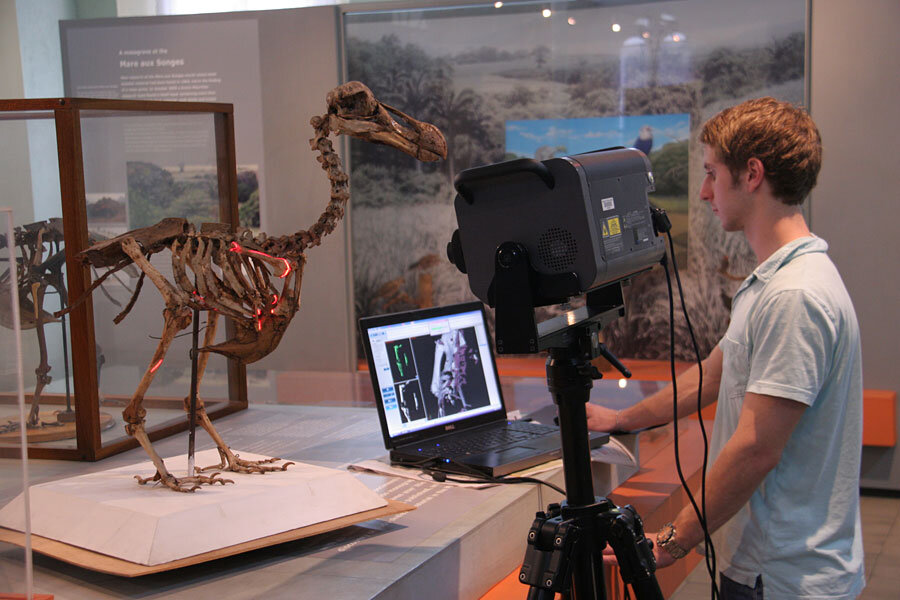What were dodos like?
Loading...
If one were to rank animals according to the magnitude of their legitimate grievances against Homo sapiens, a good candidate for the very front of that line would be the dodo.
Three-feet tall, flightless, and, rather improbably, a member of the pigeon family, the dodo lived a peaceful existence on the island of Mauritius, some 1,200 miles off the southeastern coast of Africa, growing ever larger for millions of years right up until about 1600, when the first Dutch colonists arrived on the island.
After that, things went downhill very quickly for the bird. Unaccustomed, and more importantly un-adapted, to dealing with predators, the dodo was easily bagged by hunters and devastated by the animals the settlers brought with them, particularly dogs, who were known to destroy their nests. A short eight decades later, the dodo was extinct.
Even after the last dodo made its exit, the indignities didn't stop. Dodo remains were, at times, treated with little regard for preservation. In 1755, the director of the Ashmolean Museum in Oxford tossed into a fire the taxidermied version of the last dodo seen in Europe. Present-day scientists have access to a miscellany of dodo bones, but they come from nearly as many dodos.
Sometime at the turn of the 20th century, barber and amateur collector Etienne Thirioux was searching the countryside of Mauritius and came upon the world's only known complete skeleton of a dodo. Thirioux attempted to contact scientists in Europe, but he found the scientific community uninterested and never received full recognition for his finding, says Leon Claessens, a vertebrate paleontologists at the College of the Holy Cross, who led a new study of the Thirioux skeleton.
"In the dodo, it's almost like you have this reoccurring theme," says Dr. Claessens. "There's information around but it somehow gets lost and forgotten."
But perhaps now the dodo is receiving some of the attention it deserves. Claessens and his colleagues have conducted a 3D laser scan of the Thirioux skeleton, uncovering a wealth of new information about the dodo that for centuries had proven elusive.
Though Thirioux's full skeleton was put on display at the Natural History Museum in Port Louis, Mauritius, no biologist until now actually examined the set of bones; perhaps all who had the opportunity assumed that the bones could not possibly yield any new information.
Now, by investigating the bones of the Thirioux skeleton and one composite skeleton taken from multiple birds, the researchers looked to answer important biological questions, like how the dodo walked, with more detail than before. But the findings, which were presented this week at the 74th Annual Meeting of the Society of Vertebrate Paleontology in Berlin, also identified a need for the team to take a step back and focus on the hefty task of mapping out the anatomy of the dodo.
Biologists already knew that evolution led the dodo, in a relatively short period of time, to acquire a significant amount of body mass. They did not fully understand, though, exactly why this adaptation took place: the generous increase in body weight would normally require equally major changes to the animal's bones.
So, working on site at the museum in Port Louis and in Durban, South Africa, Claessens and his colleagues performed 3D surface scans of the skeletons. But it turned out that their initial set of questions would have to wait. The team discovered that a number of bones, including some in the knee and the tips of the wings, had never been analyzed and described before.
"It unlocks all these possibilities and allows this global dissemination of what a dodo really is," says Claessens.
Understanding the dodo better doesn't just include constructing a more accurate picture of its size or features, according to Claeseens. The endeavor also requires changing our overall perception of a bird, which at times was considered as mythical as the mermaid because of its all-too-brief cohabitation with humans.
"Even though the dodo has this cultural stigma to it of being clumsy and an evolutionary failure destined for doom, I would say no," says Claessens. "This was an organism perfectly adapted to life on Mauritius, but nobody is going to survive having the ecosystem disrupted at tremendously heavy rates."
It wasn't until the late 1700s, about one hundred years too late for the dodo, that humans began to grasp the concept of a species going extinct, says Claessens. Recognizing the destructive role that humans played in the rapid demise of the dodo could help in spotting the direct links between human behavior and population declines of species around the globe today.
"It's going to give us a better understanding of what are some of these processes involved when you have rapid changes that really put animal populations under stress," Claessens says.






